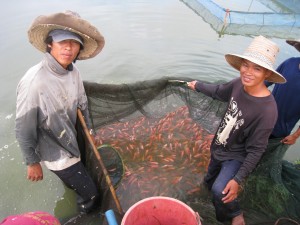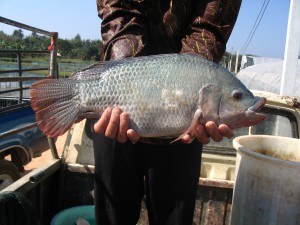This article was originally posted on Randy and Cheryl Bevis’ blog. They are Covenant missionaries in Thailand.

The main project that I (Randy) have been working with for the last 14 years is a good size tilapia hatchery that we have developed to be an income generator for ministries here. It is much more than that as we integrate our faith into the project and with the lives of the people that have become involved with the hatchery. We started with four acres in 1998 with about six staff . We have grown to two sites of 15 acres for the black tilapia and 12 acres for a red tilapia hatchery and have a staff of 36 people. There is much talk these days about Business as Mission and our hatchery is a good example of running an operation that employs people and is generating livelihoods for those around us.
Why a Hatchery?
Fish farming is playing a continually more important role in providing food for the world’s growing population. Wild fish stocks harvests plateaued worldwide about 20 years ago and have even gone down. Where is added fish going to come from to feed people? Half of the world’s consumption of fish now comes from fish farms. Hatcheries play an important role in providing the fish stock for farmers who grow them.

Why Tilapia?
Tilapia come from central to northern Africa long the rift valley that flows north into the Nile River. It is a fish that can live in many environments. Some of the areas of Africa have inland saline lakes that in the dry season has salt content that exceed oceans. So certain tilapia species can be grow in full sea water, brackish water as well as fresh water. Tilapia like 30 degrees celsius water (86 F), but can live in temperatures down to 10 C and up to about 100 C. Most of the world‘s population lives in the tropics (Central, South America, Africa and Asia), so tilapia can be grown well in most of these places close to the worlds highest population densities. Tilapia can handle low dissolved oxygen (0.2 mg O2/L). They are omnivores and can eat many things but their main diet is phytoplankton which is about as low as you can get on the food chain so they are very sustainable unlike some fish that you must feed a large amount of fish meal in their diet. Kill fish to make fish meal to feed to fish is not the best use of resources and it takes away fish from the world’s poor to make expensive fish for the world’s wealthy.
Ease of Breeding
To be able to produce fish for daily markets it is important to have a fish that is easy to breed and can produce offspring year round. Few fish can do this as most have certain seasons that they spawn i.e. many spawn only during the rainy season. Tilapia are mouth brooders. We have about 20,o00 breeders on our farm in net enclosures and collect eggs from the females mouths every seven days. While not every fish spawns every seven days, we get harvest rates of about 30 to 60% on a given week all year long. On a good month we can collect about 10 million tilapia eggs this way. A good size female can have up to 1500 eggs in her mouth.

Leave a Reply